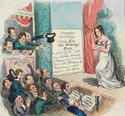 Although now much altered, the Dumfries Theatre Royal, built in 1792, is the oldest standing theatre in Scotland. It is the last of Scotland's Georgian theatres, the most significant of which was the Theatre Royal in Edinburgh which opened in 1769. But in Glasgow too theatre activity and theatre building grew through the late 18th century and into the 19th century.
Although now much altered, the Dumfries Theatre Royal, built in 1792, is the oldest standing theatre in Scotland. It is the last of Scotland's Georgian theatres, the most significant of which was the Theatre Royal in Edinburgh which opened in 1769. But in Glasgow too theatre activity and theatre building grew through the late 18th century and into the 19th century.
 The first permanent theatre in Glasgow was built in Dunlop Street by John Jackson, the manager of the Edinburgh Theatre Royal, and opened in January 1782. For the first fifteen years of its life (the theatre survived until 1869) the house was a second home for the company of the Edinburgh Theatre Royal. In common with other provincial theatres major stars appeared on its stage, not least Sarah Siddons, the eminent tragedienne, and Master Betty, the prodigious child actor. When, in 1805, Jackson transferred his interests to the new Theatre Royal in Queen Street, the Dunlop Street theatre was renamed the Caledonian and became Glasgow's "minor house" with a programme of musical entertainments, equestrian dramas and pantomime. In 1825 Frank Seymour snatched the lease for the Caledonian from revival theatre manager J H Alexander. The latter retaliated by leasing the cellars of the building and opening them as "The Dominion of Fancy". A colourful war of attrition waged between the two theatres until Alexander emerged victorious with the lease for the theatre secured.
The first permanent theatre in Glasgow was built in Dunlop Street by John Jackson, the manager of the Edinburgh Theatre Royal, and opened in January 1782. For the first fifteen years of its life (the theatre survived until 1869) the house was a second home for the company of the Edinburgh Theatre Royal. In common with other provincial theatres major stars appeared on its stage, not least Sarah Siddons, the eminent tragedienne, and Master Betty, the prodigious child actor. When, in 1805, Jackson transferred his interests to the new Theatre Royal in Queen Street, the Dunlop Street theatre was renamed the Caledonian and became Glasgow's "minor house" with a programme of musical entertainments, equestrian dramas and pantomime. In 1825 Frank Seymour snatched the lease for the Caledonian from revival theatre manager J H Alexander. The latter retaliated by leasing the cellars of the building and opening them as "The Dominion of Fancy". A colourful war of attrition waged between the two theatres until Alexander emerged victorious with the lease for the theatre secured.
 The newly built Theatre Royal in Queen Street was Glasgow's first legitimate theatre – that is a theatre that held a royal patent that licensed it to produce the spoken drama. It was a very much grander affair than the Dunlop Street theatre – one of the grandest outside of London – but the Glasgow population was neither large enough nor rich enough to maintain such a large venue, particularly given the success and celebrity of the local minor house. It struggled for success, this despite frequent visits by the actor Edmund Kean and a reputation for spectacular and extravagant productions. The theatre's sheer size meant that it was never a commercial success.
The newly built Theatre Royal in Queen Street was Glasgow's first legitimate theatre – that is a theatre that held a royal patent that licensed it to produce the spoken drama. It was a very much grander affair than the Dunlop Street theatre – one of the grandest outside of London – but the Glasgow population was neither large enough nor rich enough to maintain such a large venue, particularly given the success and celebrity of the local minor house. It struggled for success, this despite frequent visits by the actor Edmund Kean and a reputation for spectacular and extravagant productions. The theatre's sheer size meant that it was never a commercial success.
 When the Theatre Royal in Queen Street was ravaged by fire in 1829 the letters patent transferred to the Dunlop Street venue. Despite the destruction of the auditorium, much of the facade was preserved and still remains in place at the junction of Queen Street and Exchange Square.
When the Theatre Royal in Queen Street was ravaged by fire in 1829 the letters patent transferred to the Dunlop Street venue. Despite the destruction of the auditorium, much of the facade was preserved and still remains in place at the junction of Queen Street and Exchange Square.